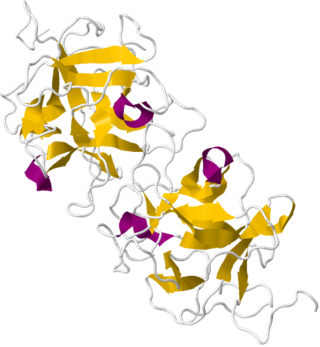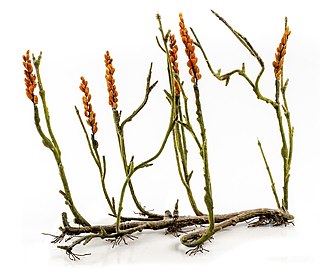
Mackerel is a common name applied to a number of different species of pelagic fish, mostly from the family Scombridae. They are found in both temperate and tropical seas, mostly living along the coast or offshore in the oceanic environment.

The International Union for Conservation of Nature (IUCN) Red List of Threatened Species, also known as the IUCN Red List or Red Data Book, founded in 1964, is an inventory of the global conservation status and extinction risk of biological species. A series of Regional Red Lists are produced by countries and organizations, which assess the risk of extinction to species within a political management unit.

A booby is a seabird in the genus Sula, part of the family Sulidae. Boobies are closely related to the gannets (Morus), which were formerly included in Sula.

Miraculin is a taste modifier, a glycoprotein extracted from the fruit of Synsepalum dulcificum. The berry, also known as the miracle fruit, was documented by explorer Chevalier des Marchais, who searched for many different fruits during a 1725 excursion to its native West Africa.

Synsepalum dulcificum is a plant in the Sapotaceae family, native to tropical Africa. It is known for its berry that, when eaten, causes sour foods subsequently consumed to taste sweet. This effect is due to miraculin. Common names for this species and its berry include miracle fruit, miracle berry, miraculous berry, sweet berry, and in West Africa, where the species originates, agbayun, taami, asaa, and ledidi.

Synsepalum is a genus of trees and shrubs in the chicle family, Sapotaceae described as a genus in 1852.

Synsepalum brevipes is a shrub or medium-sized to large tree in the family Sapotaceae, that is native to the African tropics and subtropics.

A species that is extinct in the wild (EW) is one that has been categorized by the International Union for Conservation of Nature as known only by living members kept in captivity or as a naturalized population outside its historic range due to massive habitat loss.
Synsepalum aubrevillei is a species of plant in the family Sapotaceae. It is found in Côte d'Ivoire and Ghana, and is threatened by habitat loss.
Synsepalum brenanii is a species of plant in the family Sapotaceae. It is endemic to Cameroon. Its natural habitat is subtropical or tropical dry forests. It is threatened by habitat loss.
Synsepalum kassneri is a species of plant in the family Sapotaceae. It is found in Kenya, Mozambique, Tanzania, and Zimbabwe.
Synsepalum tsounkpe is a species of tree in the family Sapotaceae with edible fruit. It is endemic to Côte d'Ivoire. It is threatened by habitat loss.

Zosterophyllum was a genus of Silurian-Devonian vascular land plants with naked branching axes on which usually kidney-shaped sporangia were arranged in lateral positions. It is the type genus for the group known as zosterophylls, thought to be part of the lineage from which modern lycophytes evolved. More than 20 species have been described.

Euptera elabontas, the common euptera, is a butterfly in the family Nymphalidae. It is found in Ivory Coast, Ghana, Benin, Nigeria, Cameroon, Equatorial Guinea, Gabon, the Republic of the Congo, the Central African Republic, the Democratic Republic of the Congo, Uganda, Kenya, Tanzania and Zambia. Its habitat consists of forests.
Amorphospermum is a genus of plants in the family Sapotaceae described as a genus in 1870.
Synsepalum revolutum is a species of flowering plant in the family Sapotaceae, native to west and west central tropical Africa. It was first described by John Gilbert Baker in 1877 as Sideroxylon revolutum.









